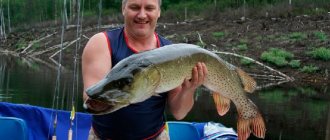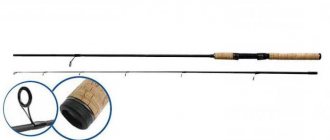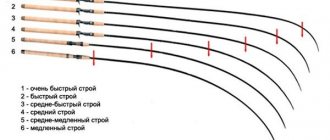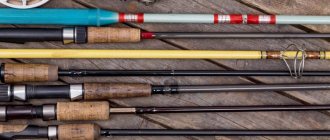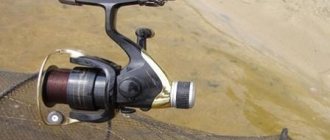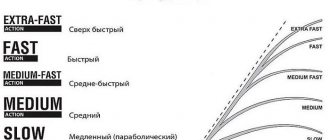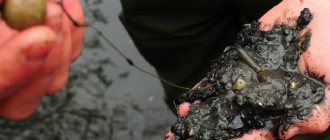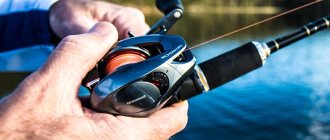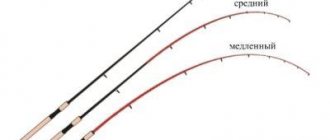How to increase the range and accuracy of feeder casting
One of the distinctive features of the feeder (as well as its undeniable advantage) is the ability to make ultra-long casts to the most remote corners of the reservoir. With such a tool, no fish can feel safe.
At the same time, long-distance casting requires quite serious theoretical and practical training. It is unlikely that a novice fisherman, holding a feeder in his hands for the first time, will be able to accurately throw the feeder at the usual seventy to eighty meters. In fact, very little depends on arm strength and muscle mass. This article will display the main factors that contribute to ultra-long and accurate casting.
Rod length and test - analyzing the keys to success
It is quite obvious that a long rod allows for much longer casts than a short rod like a picker.
The principle of the relationship between the length of the lever and the amount of force applied has been known to everyone since school. Therefore, a long rod is the basis for long casting. A standard three-meter rod can handle a distance of the aforementioned seventy to eighty meters. Of course, the longer it is, the less force the fisherman will have to exert when casting such a distance - and, accordingly, the smaller the error will be. In addition to length, the test range of the rod has a significant influence on the casting distance and ease of casting. It is known that going beyond the upper limit of this range is extremely undesirable and is fraught with the worst consequences - up to and including irreparable breakdown of the feeder. Too little weight will not allow the feeder to fly far. The most optimal load, which allows you to throw it with the greatest accuracy to the maximum possible distance under given specific conditions, is considered to be a load with a weight equal to three-quarters of the upper limit of the test range. In other words, if a fisherman uses a middle-class feeder with a test from sixty to one hundred grams, then the optimal weight of the feeder will be seventy-five grams - it is with such a load that it will be possible to make the longest and most accurate casting. Of course, these figures are purely advisory, but they were selected according to the opinion and experience of sport fishing veterans, for each of whom such a ratio is obvious and self-evident.
Clipping for standard feeder
By standard feeder we mean ordinary fishing for not too large fish, when releasing the fishing line from the clutch or its free movement at the time of the bite is not required. That is, the working length is limited by the clipped cord - this is the majority of cases of feeder fishing. The usual methods of securing the cord are in a bobbin clip or with an elastic band. But even with these standard methods, questions often arise. Read more about feeder tactics and techniques.
Types of clips on the spool
The following types of clips are found on reels used in feeder fishing:
- Plastic triangular is the most common option.
- Round metal.
- Clip with release system.
The self-resetting clip is positioned as an invention for carp fishing - when the cast is jerked, the cord is held in place, but when a large fish pulls strongly, the braid is reset, ensuring further free flow of the line. This is the ACS (Auto Clip System). ACS is found on a limited number of reels and was quite widely advertised at one time (for example, the MAP ACS 4000 reel). However, the new product did not catch on. According to anglers' reviews, this system works normally only at short distances and when using a monofilament. This does not work on thin cords. And on a picker (close distance and monofilament) heavy feeders are not used - for clipping, an elastic band or a standard plastic triangle on the spool is enough.
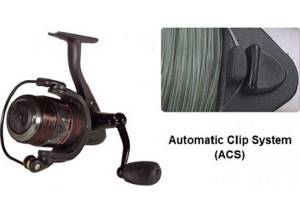
More often, a triangular plastic clip is placed on the reels. Problems of damage to the braid, shooting when casting or breakage of the clip in 90% of cases occur precisely with this clip design. This happens due to burrs and sharp edges, general poor quality of the product, or during merciless operation with large weights of feeders (due to damage and wear of the cord at the clipping point). However, on good reels, a backing (for example, made of fluoroplastic) is installed under the clip. In addition, you can make safety improvements for the braid (more on this below). The correct coils for the feeder.
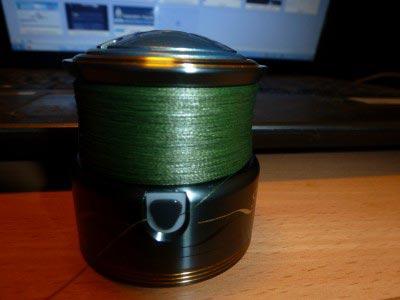
Plastic clip with backing
The safest is a round metal clip. This part is usually installed on expensive reels, specially designed for long-distance casting of a feeder or carp rod. You can install such a clip instead of a plastic tongue yourself or in a workshop (if they know how to do this, of course).
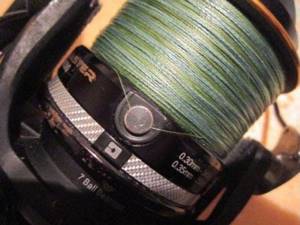
Round clip
Video about making a round clip from screw rivets yourself:
Fixing the cord into the spool clip
Standard clipping - winding the cord behind the spool clip. If it is round metal, a whole turn is made around the stump under the cap - this is the most reliable method, the braid is not injured, and there is no chance of spontaneous release. It is not recommended to wrap it around a plastic triangular tongue - the bend is too large, and the likelihood of damage to the braid or breakage of the clip increases.
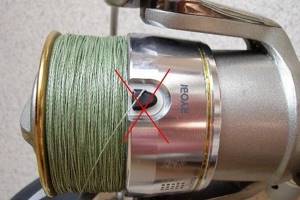
With normal clamping, the braid will sooner or later be injured at the point of friction against the sharp edge of the plastic tongue, especially when using heavy feeders. Therefore, when heavy fishing, it is worth protecting the braided line. To do this, just wrap the clipping point on the cord with electrical tape (seal the cord in a piece of tape like in a book). Another alternative option is to place a piece of feedergam under the tongue, slightly longer than the width of the clip, with two knots on the edges (so that it doesn’t fly out). In this case, the fishing line will no longer rub against the edge of the tongue directly, but will put pressure on this peculiar backing. Another option for safe clipping is to place a piece of 0.5 mm feedergam in advance, even before winding the cord, as in the figure below.

A piece of feeder rubber in a clip for winding the cord
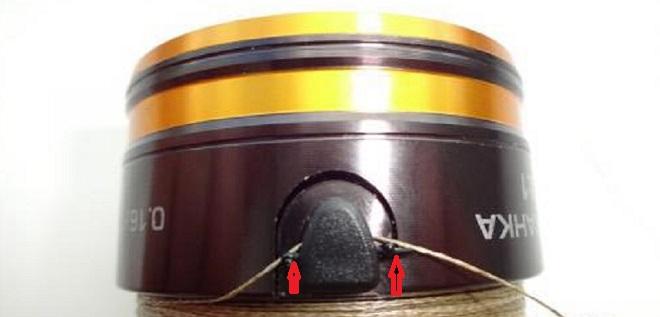
Gasket – a piece of feedergam with two knots
The general approach to working with tackle is the following - if the usual method turns out normal, the cord is not injured, then clipping the line is necessary (close distance, light weight feeders). However, if there are any concerns, or worse, shooting, we use another method of clipping - using an elastic band.
Clipping with an elastic band
You need to clip the line onto the feeder with an elastic band if the angler is not sure of the quality of the reel clip. This method is recommended for beginners. The disadvantage is that it is inconvenient when frequent re-clipping is necessary, for example, when measuring the bottom and relief. That is, when measuring, we use regular clipping (under the tongue). Once the distance is chosen and there is no need to change it, we use an elastic band. The safest system of action:
- Place a piece of feedergam with knots under the clip. We pinch the braid under the clip while measuring the bottom.
- When fishing, we clip it with an elastic band.
The disadvantage of this method of clipping is the same - the impossibility of using the clutch immediately after hooking a trophy fish. However, the presence of an elastic band simplifies the situation. There is no need to pick out the cord from under the tongue - you can simply tear the rubber with force and remove the fish, already using the friction brake. And for the next casts use another one. Materials:
- Banking rubber band;
- Stationery rubber rings;
- Rubber for beading;
- Feeder Gum.
Standard rubber fastening method (recommended):
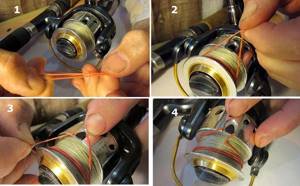
Loop method (not recommended - if necessary, quickly break the harness for fishing on the clutch; the emphasis of the jerk force is not on the spool, but on the cord):
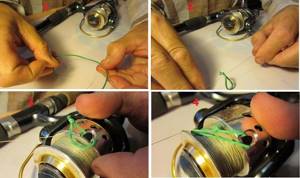
The most common material is regular rubber bands. However, they quickly deteriorate and tear. Fishermen have found a solution to the problem - a regular feeder or an elastic band for beading. These materials are more durable and reliable, and also have a smaller diameter and round cross-section (improves even winding of the line from above). A loop is knitted from an elastic band (a regular knot or a figure eight), then it is installed on the bobbin in the same way as a bank one. When clipping, it is the knot that is wound under the tongue, since placing it directly on the spool spoils the quality of winding. Elastomeric thread for beading costs about 50 rubles; one bobbin is enough for all fishing trips for years to come.
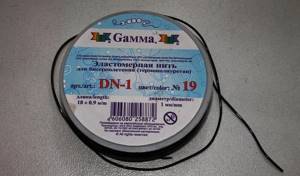
Beading rope
Harness the potential of slow builds
Another important factor when making long casts with a feeder rod is taking into account the capabilities of its structure. Under the influence of the load when hooking, leading and fishing for fish, fast action rods are capable of bending by one third of their length. During a long cast, this flexible part produces a fairly sharp but short push. In other words, from swinging the rod to the moment when the feeder begins to move in the air on its own, very little time passes. Slow action rods have the ability to bend throughout their entire length - right up to the butt. Thanks to this amazing flexibility, the rod blank bends strongly at the moment the cast begins, and after its completion, the tip of the rod continues to move at an ever-increasing speed before it uses up its reserve of movement and sends the feeder into free flight. In such conditions, it is obvious that with equal expenditure of physical strength, rods with a slow action have an incomparably greater potential and predisposition to make long and ultra-long casts.
What elements does the feeder consist of?
The configuration of such gear is not very different from spinning gear, but there are differences:
- rod;
- fishing line or cord;
- coil;
- equipment: feeder, weight, leashes, hooks, anti-twisters, stoppers;
- a set of interchangeable tips (quivertips);
- bite alarms;
- accessories for feeder fishing.
Feeder rod
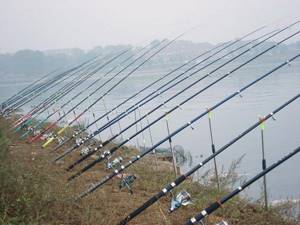
When choosing a fishing rod, a beginner should know its characteristics. This is necessary in order to select the right equipment for certain equipment parameters or vice versa. It is necessary to choose tackle taking into account the material from which it is made, test, action, length and quivertypes.
Material
Carbon (carbon fiber), fiberglass or composite materials are used to make blanks for feeder gear.
Fiberglass material is characterized by good flexibility and elasticity. Fiberglass blanks are a budget option and have a low price. The disadvantage is the heavy weight.
Carbon material is lighter in weight, has a high level of strength and flexibility, and can withstand heavy loads when playing fish. The main disadvantages are its high price and the fragility of the material in places exposed to impacts. These blanks can easily withstand the bending load that occurs when the fish jerks. But they can break in the place where there was a previous blow, for example, with a sinker or on a stone. Always place the tackle on a stand. You can damage the form by stepping on it or hitting it against a rock. Try not to hit the form with a sinker or feeder.
A composite rod has some of the characteristics of both fiberglass and carbon. It is less fragile than carbon fiber and lighter than fiberglass. This is a universal and ideal option for a beginner.
Test
The choice of the test depends on the weight of equipment that will be used.
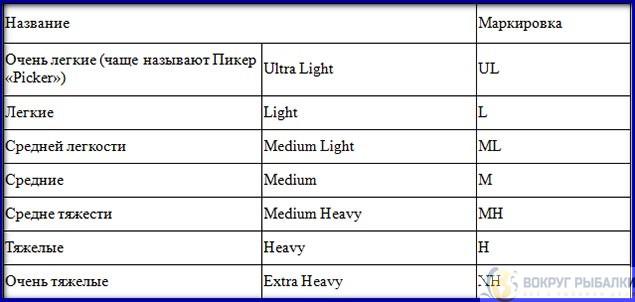
The choice of spinning test depends on the fishing location. In shallow areas or a quiet river, a rod with light to medium light dough will do. At greater depths or currents, it is recommended to use “sticks” with medium or medium-heavy dough.
Rod length

The casting distance and the convenience of landing fish depend on this indicator. Blanks are available in lengths from 1.6 m to 4.5 m. Long bits are good because they are capable of casting over a considerable distance. These are rods with a length of 2.4 m. With such gear it is easy to control the landing of fish, but they are less compact and have significant weight. They can be used in coastal areas where there is no vegetation or objects that interfere with the swing.
For fishing from a shore planted with plants or a boat, the desired gear size is up to 2.1 m.
For beginner fishermen, tackle lengths from 1.8 m to 2.4 m are suitable for training.
Quiver Tips
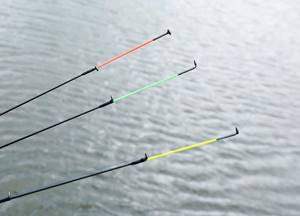
The replaceable tip of the feeder tackle, which serves as a bite alarm, is called a quivertip. Tips (usually 3–5 pieces) are included in the rod kit. They are characterized by different hardness (test) and are installed on the rod depending on the weight of the equipment filled with bait. The test may be expressed in grams or English ounces (Oz). The ratio of one ounce to grams is 1 to 28.3. The smaller the quivertype test, the more sensitive it is to fish bite. Budget feeder kits only include 1, 2, and 3 ounce extra tips. The more expensive ones also have 4 and 5 ounce tips.
The influence of guide rings on casting distance
It seems less obvious, but the guide rings, namely their location, diameter and quantity, are also of no small importance when making long- and ultra-long-range casts with increased accuracy. First of all, the role is played by the wear resistance and quality of the throughput rings - in other words, their ability to resist the deforming effects of friction of a fishing line or braided cord passing through them, without being cut or losing their throughput properties from the accompanying heating. In particular, one of the main problems due to overheating may be subsequent peeling and popping out of the internal inserts. In addition to this, the pass ring inserts of budget feeders are often unsuitable for use in combination with braided cords.
The best in terms of price and quality ratio today are considered to be inserts made of aluminum oxide, porcelain and titanium nitride, as well as metal ceramics coated with silicon carbide. The most popular manufacturer is Fuji.
In addition to the inserts, the casting distance is also affected by the diameter of the guide rings. Increasing it allows you to significantly reduce friction when casting - and, accordingly, the loss of speed when making long casts.
Today, the new trend in the design of guide rings for spinning rods is triangular rings, which, due to their design features, can contact the fishing line only at no more than three points. This significantly reduces friction and helps increase casting distance. It is quite possible that feeder rods will soon acquire such a tool.
Hard to learn, easy to fish
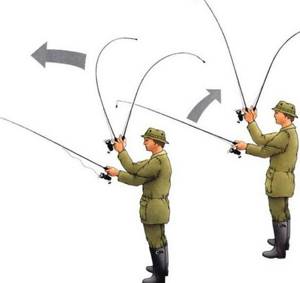
The most important thing when making a long-distance casting of a feeder is, of course, the accuracy of its splashdown. In addition, the angler must cast in such a way as not to accidentally break the feeder, tear the gear, or injure himself or others around him. Correct casting requires repeated training with ordinary weights and without a hook. Many anglers specially come to some secluded pond or ordinary field just to practice making long casts with a feeder. With this practice, casting ability, accuracy and a sense of distance will come naturally.
Fishing with a feeder at a long distance

When fishing with bottom gear in large water areas, it is often necessary to make long casts. The fish can be located near the riverbed or in the area of the far edges. Therefore, you should have feeder equipment designed for casting over a distance of over 60 meters. In this article we will look at how to fish at long distances with a feeder, how to properly equip a fishing rod, what baits and attachments are used in such cases.
The fishing line must also be correct
In combination with a feeder (especially when making long and ultra-long casts), it is best to use monofilament fishing line. Braided cord undoubtedly has a number of undeniable advantages, but monofilament fishing line forgives many of the angler’s mistakes, which is especially important when making long casts. After all, this is difficult to accomplish not only for a novice fisherman, but even for an experienced fisherman. The braided cord practically does not stretch, perfectly displaying bites on the signaling tip - it is precisely this quality that does not allow it to compensate for excessive load.
It’s worth starting to practice long casts with a medium-stretch line with a diameter of two tenths of a millimeter. Due to its fairly good stretchability, it will help in mastering the technique of making long casts with a feeder rod, minimizing the likelihood of breakage of tips, spontaneous detachment of feeders and helping to increase casting accuracy.
Leads and hooks for long-distance fishing
As a rule, when fishing with long casts, thicker leashes are used. The optimal diameter for warm weather will be 0.16-0.18 mm, and for cold weather - 0.12-0.14 mm. Fish in remote areas are not as careful as near the shore and bite more boldly. The length of the leash depends on the strength of the current. On reservoirs and quiet rivers, many fishermen make do with leashes from 20 to 30 cm long. There is no point in using longer ones; bites are clearly visible and there are few escapes if the hooks are sharp. For method installations, the shortest leashes are used, up to 5 cm.
When fishing in the middle reaches, leashes 50 cm long are most often used. When the bite is active, they switch to shorter leashes. And if the fish doesn’t want to take it, then they use longer leashes.
When fishing in rapids and areas with strong currents, use leashes from 70 cm to 1 meter in length. Sometimes they put it even longer. When fishing for saberfish, leashes from 1.5 to 2 meters are used. If fishing is carried out near a steep edge and the fish is not very active, then we use thin leashes and be sure to attach a piece of feeder 6-10 cm long.
We use slightly larger hooks and with thicker wire than when fishing at close range. Thin hooks can cut through the delicate lips of the fish and there may be slips during fishing. This sometimes happens over long distances. It is optimal to use hooks No. 9-14 according to international numbering. When fishing for bream and other large fish, it is better to use larger models with a long shank. It is easy to attach several attachments to them, forming sandwiches.
During training, it is recommended to follow a certain set of rules:
1. Instead of a feeder, it is better to use a sinker - it is not so offensive to lose it during training, since it is much cheaper. In addition, using a sinker makes it easier to hit a specific point.
2. The key to successful training is the correct assembly of the feeder. In particular, all access rings must be located strictly in a row. The force of friction and the speed of movement of the fishing line when passing through them depend on this. All this directly affects the casting distance and accuracy.
3. The sinker or feeder should be tied at a distance of one meter or more from the signaling tip.
4. The guide hand (right hand for right-handers, and left hand for left-handers) is placed close to the lower leg of the reel. The right index finger should press the line against the rod blank. The second hand is placed at the end of the handle - it is from this position that the long cast of the feeder should be carried out.
5. To prevent the fishing line from getting tangled in the rings of the signaling tip when casting, it is necessary to continuously monitor the condition of the braided cord or fishing line. Just before casting, with your right finger you need to try pressing the line a couple of times, pressing it against the rod blank to make sure that it passes freely through the guides.
6. The casting algorithm is as follows. The rod is moved back smoothly and carefully until the reel is pointing upward. All this time it is necessary to ensure that the fishing line does not overlap, pressing it with your finger against the rod blank. Casting is still smooth. The guiding arm is fully straightened, the driven arm is moved to the chest. At the moment when the rod takes a vertical position in relation to the plane of the water, it is necessary to remove the finger pressing the fishing line in order to release it.
7. The first casts should always be made smoothly. Later, when the fisherman gains experience and practice, it will be possible to try to make high-speed casts over long distances using great physical force.
8. During the free flight of a sinker or feeder, the rod must be returned to a strictly vertical position in relation to the plane of the water. At the moment the feeder splashes down, it should be at an angle of seventy to eighty degrees above the horizon. This measure will sufficiently compensate for the removal of the fishing line after it is fixed. Otherwise, when holding the rod in a horizontal position, there will be a high probability of breakage or damage to the tackle.
What bait should I use?
When fishing at long distances, use bait that holds well during the flight. For example, when fishing with method rigs, the food is made more viscous so that it does not fly out when casting.
A good option for such cases is to use mastyrka mixed with breadcrumbs. The result is an ideal bait that has a high calorie content. It molds well, stays securely in the feeder when flying, and is liked by bream and other white fish. When it gets to the bottom, it does not lie like plasticine, but is gradually washed away. This is facilitated by small crumbs of crackers. Even in a quiet body of water, bait will work very well. Moreover, this composition does not require any additives, except “cosmetic flavoring” in the form of vanillin.
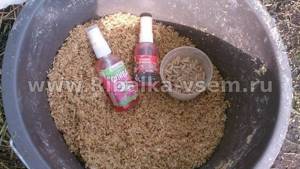
When fishing at long distances in warm weather, high-calorie baits are used. The fish are active at this time and it is difficult to overfeed. On the contrary, if there are insufficient nutrients, the fish can be lost. The fisherman's task is to “put on the spot” those big fish that are walking in the middle of the river. Therefore, boiled peas, wheat, pearl barley, canned corn, pellets, boiled potatoes, rolled oats, makukha and much more are added to the compositions.
Molasses, ground hemp seeds and various liquid flavors are added to the bait, which awaken the fish’s appetite. When fishing in the current, clay and soil are added, which bind the mixture into one whole.
Store-bought formulations are selected depending on the fishing conditions. If we fish on a river with a current, we use baits adapted for river fishing. When fishing in calm waters, they use mixtures whose names contain the word “Lake”.
The most tedious task in this type of fishing is maintaining a constant feeding rhythm. You have to unwind a lot of fishing line and spend a lot of time on this tedious operation. You can make your life easier if you use a feeding slingshot. Good slingshots shoot at 60-70 meters. The main thing in this process is to get better at it. To make it easier to get to one place, you can use a landmark.
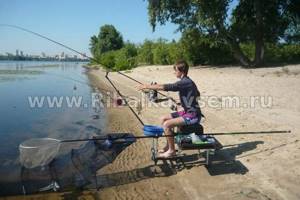
If you have a boat, you can swim to the fishing spot and place a plastic bottle in the fishing spot. In principle, you can make a starting feed from a boat, and then install a bottle tied with a rope to a stone that sinks to the bottom. With a slingshot it will be easier to feed the place, focusing on the bottle. Casting the feeder rig will also be easier.
This method of feeding will save you from frequent casting and will quickly attract fish to the point. Reel out the tackle only after bites or once every 15 minutes if there are none.
During the fishing process, you must not forget about the freshness of the bait. This is especially true during hot periods. It is better to add more molasses to it when kneading. This viscous sweet liquid will protect the bait from souring.
How to make long casting more accurate
A high casting distance is only half the task. The main role is played by accuracy, without which it is impossible to place hooks in a fairly limited feeding area. First of all, to improve the accuracy of long-distance casting, you should choose a noticeable and memorable landmark on the opposite bank - a tree, building, beach, large stone, pier, etc.). In order to re-cast at approximately the same distance as the previous one, you can make a mark on the line with a marker or simply secure it with a clip. For a number of reasons, this is especially true when using braided cord. Finally, just before casting, you should make sure that the feeder handle is pointing directly at the reference point, without deviating to the side.
